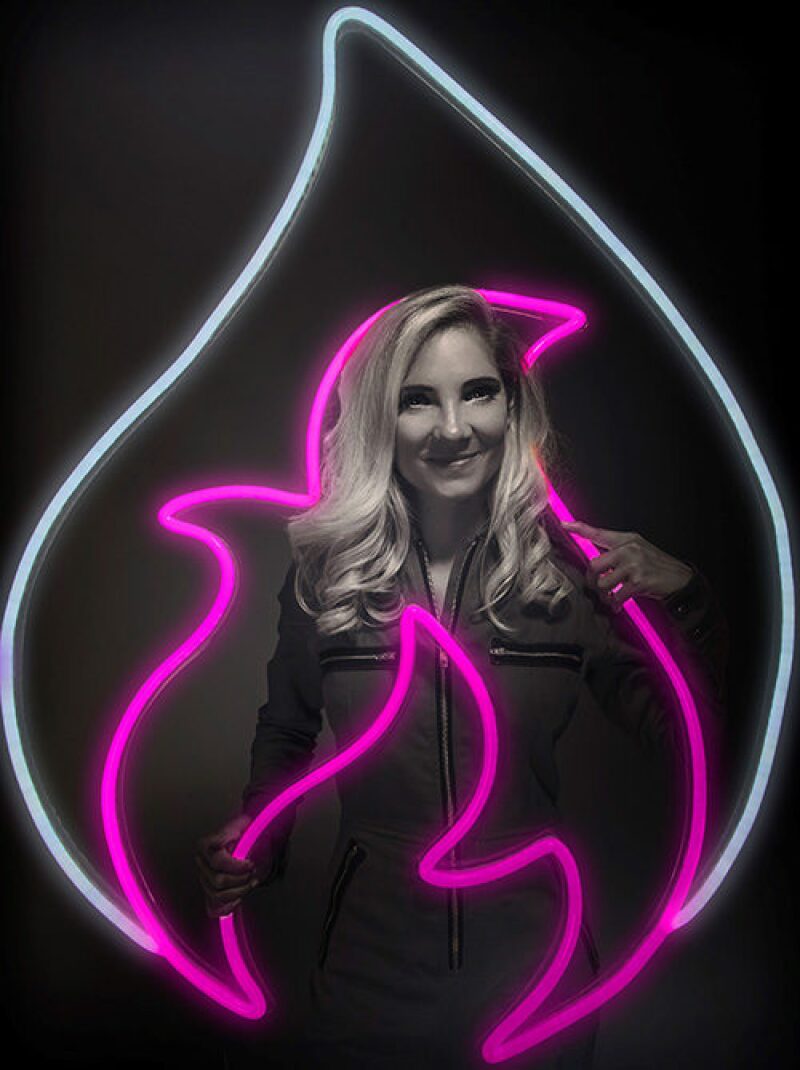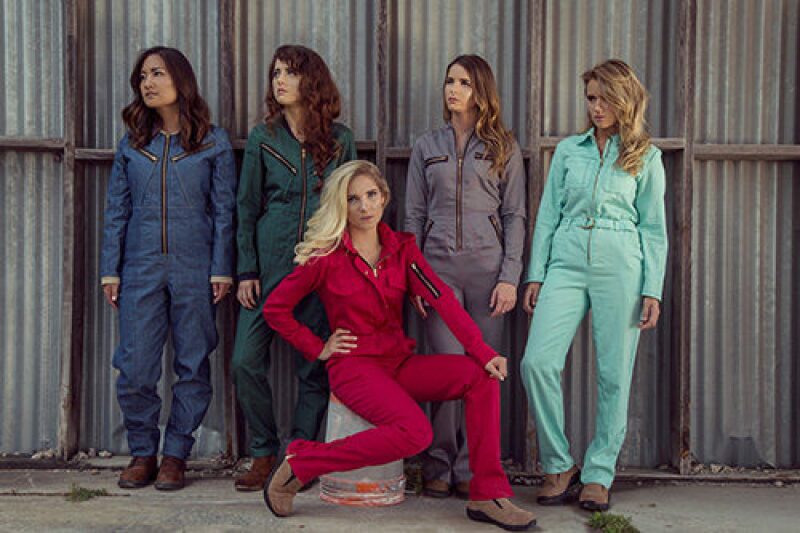Twenty-something Jaime Glas is not your typical young professional. An accomplished petroleum engineer in her own right, she has boldly ventured into the market of women’s fire-retardant clothing, launching her first line of coveralls earlier this year. The singular force behind Hot Stuff Safetywear, Glas wears many hats, juggling roles as designer, founder, and primary investor with aplomb. In this interview, entrepreneur Glas shares her thoughts on developing and launching a new product—all while maintaining her full-time job as a reservoir engineer.
Her message to YPs: "Most people just want you to succeed in the way that works best for you and makes you happiest."

Jaime Glas graduated from Louisiana State University in 2012 with bachelor’s degrees in petroleum engineering and international trade and finance, and a minor in Chinese culture and commerce. She interned three summers during college with Chevron in Bakersfield and Houston, then went to work full-time as a production engineer for Chevron’s Carthage field in east Texas. She held multiple other positions in Chevron’s Mid-Continent Business Unit during her 5 years with the company. In August 2016, Glas moved to Austin, Texas, to pursue a reservoir engineering position with Permian-focused Parsley Energy. It was then that she began to make strides in her development of Hot Stuff Safetywear and ultimately launch the company.
Many women in the oil and gas industry lament the limited options available for field wear, so it is exciting to see the launch of your new products. What prompted you to tackle the niche of women’s safety wear?
Growing up, I always had a particular interest in fashion. When I went to college, I treated my first year as a learning experience and took a variety of courses from fashion history to differential equations to Mandarin language. When I accepted my first internship with Chevron, I was truly treating the experience as a trial in the industry to see if I enjoyed the work. One of the first observations I made about life in the oil field was not only the shortage of women, but also the flame-resistant clothing options that were very clearly designed for men. After that summer, I knew I wanted to be a petroleum engineer. The industry is electric and there is an addictive feeling working for an industry that very literally fuels the world. But I always had in the back of my mind that maybe one day safety wear could be my opportunity to marry my experience in the industry and love of fashion.
Your line, Hot Stuff Safetywear, launched in June of this year. How long have you been on this journey from conception to launch?
The idea for Hot Stuff was born in 2010 during my second internship with Chevron. That spring, OSHA [Occupational Safety and Health Administration] established the requirement that all personnel involved in oil and gas well drilling, servicing, and production-related operations wear fire-resistant clothing [FRC] during the jobs. I was issued my first pair of FRCs at the beginning of that summer, as I would be working 2-weeks on/1-week off of a land drilling rig as a drilling engineering intern. I vividly remember telling my mother about the baggy coveralls I had to wear and how I wanted to change that. “You could call it Hot Stuff!” Right then and there the concept was born, but it has a taken few ups and downs in the oil industry for the company to come to fruition.
As safety wear, your coveralls require not only fashion design, but also must adhere to safety regulations. For those unfamiliar with the requirements, would you please describe the process of certification?
The code that sets the standard on flame-resistant garments for protection of industrial personnel against flash fire is NFPA 2112. Similarly, NFPA 70E sets the standard for protection against thermal hazards of an electric arc. Most flame-resistant brands strive to comply with both of these standards, which require extensive testing for certification. The first step for us was to seek out component (fabric, zippers, snaps) suppliers whose products were already certified by a third party testing facility, such as Underwriters Laboratories.
Not only do the components themselves need to pass stringent testing, there are design requirements that the garments must adhere to. For example, no metal on the entire garment can be touching the skin when worn, and each garment alone must abide by this. This seems simple—put flame-resistant fabric backings on all zippers and snaps/metal buttons—however, even bib overalls, which are meant to be worn over a shirt, must comply with this requirement. Once the garments are completely finished, you put them through the testing process for final certification.

Your products lie at the intersection of the personal safety wear industry and the world of fashion, and you sketched the designs yourself. Coming from an oil and gas background, what has surprised you most as you have learned to navigate these other industries?
The biggest challenge for the development of this brand has been finding a trusted manufacturer to make the final sales garments. Though my vision is to create fashionable work wear, safety is always of utmost importance. In the oil and gas business, there is usually a surplus of companies offering services to the operators. You can shop around and try out different partnerships. There certainly isn’t an overwhelming number of manufacturers that have experience constructing flame-resistant clothing. Finding the right one has definitely been tricky. One thing the two industries have in common, of course, is making sure that the service providers you use put safety above all else.
Good ideas are a dime a dozen, but only a few people ever act upon them. What motivated you to do more with your idea and pursue this passion? What challenges or setbacks did you have to overcome in the process?
I have always been a firm believer that if you have an idea and you don’t act on it, someone else will. Moreover, I am not afraid of failure, because life is a journey and there is something you can learn from every experience.
I felt strongly connected to this idea from the beginning because of my background and interests. I knew that no matter what, I would be learning something new from trying to see the idea through and that excited me. I mentioned the difficulty we have had in finding the right manufacturer. For instance, I went far down the process with one manufacturer, only to have them claim insufficient capacity and pull the plug. Others wanted to take the idea for themselves.
I have learned that business is business and even if you start a project to have fun and grow, most people you deal with are only concerned about making money. Understanding this allows you to find those genuine people/partnerships that will make your venture a success.
What advice do you have for other would-be entrepreneurs who might be hesitant to pursue their dream?
What do you have to lose? Of course business ventures require time and money, but money is replaceable. And what better way to spend your time? I have learned about myself, what I want, and what I value. I have grown as a person and am proud of what I have accomplished. There is a certain confidence that you gain in coming up with an idea, working toward its development, and finding the resources to see it through. This confidence is now also applied every day in my reservoir engineering role and really in all aspects of my life.
How has your technical skillset in petroleum engineering translated into your business venture?
I can’t say there are many direct correlations between petroleum engineering and the FRC business, other than engineers wearing the clothes, but there is definitely a strong problem-solving foundation in both jobs.
I think being able to recognize a problem and strive to find a solution as quickly and economically as possible is the No.1 skill you need to succeed as any type of engineer. Brainstorming a variety of solutions is only half of the battle. You must also be able to assess the costs and values of any idea. This is certainly something I have used in creating Hot Stuff.
Originally, I had ideas to create over 13 garments in the first line. There were so many designs that I loved and wanted to develop. After assessing the economic feasibility of that, I quickly realized that 3–5 garments were plenty to start. I assessed the viability of each in the market and landed on our first collection of jumpsuits. Now that we have seen some success, our second collection of separates are in the works.
You seem to be able to do it all. How do you balance your full-time job and creating this line?
Well, there are 24 hours in a day, and I definitely use a large number of them. I usually wake up and do 1–2 hours of work on Hot Stuff before going to my full-time job in the morning, make some phone calls during lunch, then follow-up on things in the evening. I try to put in the time Monday to Friday and have the weekend to relax and see friends. I think having this time to let your mind reset and enjoy yourself is crucial. But in trying to pursue other ventures besides your day job, it is of course much easier to devote your free time when it is something you enjoy. Doing research on new styles and lines to create doesn't feel like work to me. It almost feels like online shopping.
Is there anything else that you would like to highlight that our readers might find interesting?
One of the biggest fears I have always had is changing the direction of my career or life once I have been set on a path. There were times when I thought founding Hot Stuff might jeopardize my current career trajectory or reputation among my peers and leaders. I have noticed that as engineers, being that we work in a more corporate world, we tend to treat work as the most important thing in our lives and we fear disappointing those we have worked for and who have helped us out.
As I have grown older and now experienced leaving a stable job (at Chevron) and then creating a company while holding another job, I realize that most people just want you to succeed in the way that works best for you and makes you happiest. At the end of the day, a company is a company. It is the experiences at the company and relationships you make that bring richness to your career and life.

